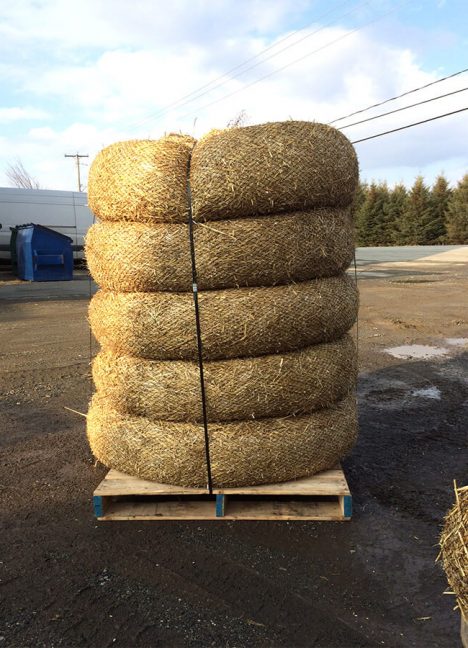Sediment retention fibre rolls
Sediment retention fibre rolls (SRFRs) are tubular nets made of synthetic or natural materials filled with natural fibres that act as a filter. The rolls are designed to slow water flow and intercept sediment in ditches and on slopes.
Products manufactured and distributed by Terraquavie
The rolls vary in diameter from 23 cm to 51 cm. Standard lengths vary from 2.44 m to 7.6 m.
The company has sufficient manufacturing capacity to make straw retention rolls (wattles) in the length that best suits your needs.
Terraquavie manufactures and stocks synthetic-netting straw SRFRs 23 cm or 30 cm x 2.4 m long.

Fonction
SRFRs are effective sediment control products. They are one of the key solutions available for implementing an environmental mitigation measures plan.
SRFRs reduce water flow velocity while capturing sediment. They can thus be used to replace or supplement silt fences. They can also be used as berms in ditches and small channels.
When used on embankments and reconstructed slopes, they increase the effectiveness of notches and furrows. In addition to reducing runoff, they help to keep fertilizer, seed and mulch in place.
Coir rolls are most often used in vegetation engineering, in bank stabilization and revegetation.
Recommendations
Unlike straw bales, sediment retention fibre rolls allow water to flow away, as the fibres composing them are not overly compacted.
Straw and wood wattles are most often used for sediment control on slopes and in ditches. Straw takes 12 to 18 months to decompose, whereas wood wool takes 18 to 24 months.
Coir rolls can withstand more rigorous constraints. They are used at the foot of banks, in areas subject to flooding and as a planting support for native vegetation. Coir takes more than 60 months to decompose.
Installation
Rolls are easy to install and require little equipment.
A trench the length of the roll is dug, one-third of the roll diameter in depth and as wide as the roll diameter. The roll is placed in the trench and secured with wood stakes at least 60 cm long, planted at intervals of 50 to 100 cm.
It is important to inspect the rolls regularly, as excess sediment buildup behind the roll prevents water from passing through it. Sediment should be removed and the roll changed as needed. In certain situations, another roll can be installed on top of the one already in place.
This protection measure can be left in place permanently and the plant fibre will decompose over a period of 1 to 6 years, depending on roll type. If the rolls need to be removed, the plant fibre can be recovered and composted. Synthetic netting must be sent to the landfill.